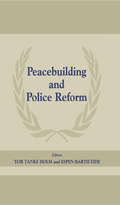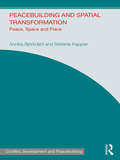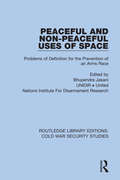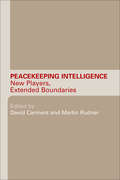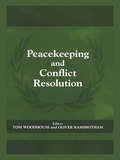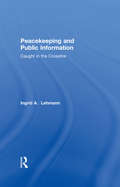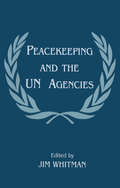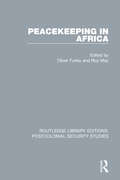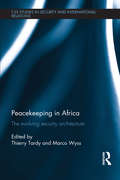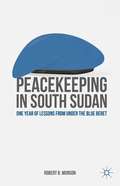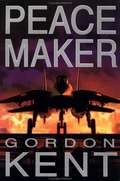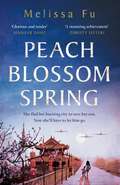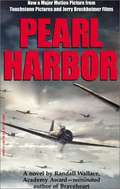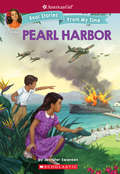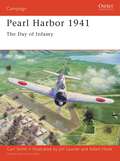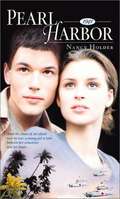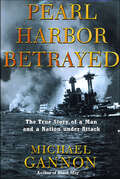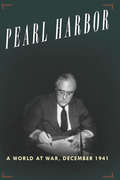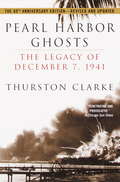- Table View
- List View
Peacebuilding and Police Reform
by Tor Tanke Holm Espen Barth EideThe contributions here discuss the issue of internationally assisted police reform in transitions from war to peace. They include theoretical insights and informed case studies and a discussion of the trend towards internationally provided executive authority policing.
Peacebuilding and Spatial Transformation: Peace, Space and Place (Studies in Conflict, Development and Peacebuilding)
by Stefanie Kappler Annika BjorkdahlThis book investigates peacebuilding in post-conflict scenarios by analysing the link between peace, space and place. By focusing on the case studies of Cyprus, Kosovo, Bosnia-Herzegovina, Northern Ireland and South Africa, the book provides a spatial reading of agency in peacebuilding contexts. It conceptualises peacebuilding agency in post-conflict landscapes as situated between place (material locality) and space (the imaginary counterpart of place), analysing the ways in which peacebuilding agency can be read as a spatial practice. Investigating a number of post-conflict cases, this book outlines infrastructures of power and agency as they are manifested in spatial practice. It demonstrates how spatial agency can take the form of conflict and exclusion on the one hand, but also of transformation towards peace over time on the other hand. Against this background, the book argues that agency drives place-making and space-making processes. Therefore, transformative processes in post-conflict societies can be understood as materialising through the active use and transformation of space and place. This book will be of interest to students of peacebuilding, peace and conflict studies, human geography and IR in general.
Peaceful and Non-Peaceful Uses of Space: Problems of Definition for the Prevention of an Arms Race (Routledge Library Editions: Cold War Security Studies #37)
by Unidir United Nations Institute For Disarmament ResearchThis book, first published in 1991, is the cumulative result of a long period of research by qualified experts in an attempt to analyse the legal and scientific problems of arriving at definitions in the task of preventing an arms race in outer space. Problems of definition confront the negotiator at the very outset of any discussion on preventing a space arms race – this book sets out to remove these problems by examining the possible definitions.
Peacekeeper (Major Ariane Kedros #1)
by Reeve Laura E.First in a brand new action-packed military science fiction series, meet Major Ariane Kedros--daring pilot, decorated soldier, war criminal. Fifteen years ago, Ariane Kedros piloted a ship on a mission that obliterated an entire solar system. Branded a war criminal, she was given a new identity and a new life in order to protect her from retribution. But now, twelve of Ariane's wartime colleagues are dead-- assassinated by someone who has uncovered their true identities. And her superiors in the Autonomist army have placed her directly in the assassin's line of fire on a peacekeeping mission that will decide the fate of all humanity... .
Peacekeeping Intelligence: New Players, Extended Boundaries (Studies in Intelligence)
by David Carment Martin RudnerThis is a new evaluation of the role, dynamics and challenges of intelligence in peacekeeping activities and its place in a much wider social, economic and political context. It assesses the role of coalition forces, law enforcement agencies, development institutions, and non-governmental organisations who have become partners in peace support activities. Peacekeeping Intelligence (PKI) is a new form of intelligence stressing predominantly open sources of information used to create Open Source Intelligence (OSINT), and that demands multi-lateral sharing of intelligence at all levels. Unlike national intelligence, which emphasizes spies, satellites, and secrecy, PKI brings together many aspects of intelligence gathering including the media and NGOs. It seeks to establish standards in open source collection, analysis, security, counterintelligence and training and produces unclassified intelligence useful to the public. The challenges facing peacekeeping intelligence are increasingly entwined with questions of arms control, commercial interests, international crime, and ethnic conflict. This book will be of great interest to all students and scholars of military and security studies, intelligence and peacekeeping.
Peacekeeping and Conflict Resolution (Cass Series on Peacekeeping #Vol. 8)
by Oliver Ramsbotham Tom WoodhouseConflict resolution theory has become relevant to the various challenges faced by the United Nations peacekeeping forces as efforts are made to learn from the traumatic and devastating impact of the many civil wars that have erupted in the 1990s. This work analyzes the theory.
Peacekeeping and Public Information: Caught in the Crossfire
by Ingrid LehmannMs Lehmann has provided a timely and challenging prescription for just how the goals of placing communication functions at the heart of the strategic management of the UN might be achieved - and a dramatic warning of the consequences of failing to do so.
Peacekeeping and the Protection of Civilians: From Moral Imperative to Effective Practice (Cass Series on Peacekeeping)
by Timothy DonaisThis book critically examines the evolution of protection practices in UN peace operations over the past two decades.Protecting civilians has become central to the work of contemporary UN peace operations, yet the ability of peacekeepers to offer meaningful levels of protection to vulnerable civilians in conflict zones remains highly circumscribed. Focusing on the implementation of protection of civilians (PoC) mandates across three high-profile UN missions – UNMISS in South Sudan, MONUSCO in the Democratic Republic of the Congo and MINUSCA in the Central African Republic – this study asks who precisely UN peacekeepers protect and how they go about protecting them. Drawing on the key distinction between coercive and non-coercive protection strategies, this book examines how peacekeepers have struggled to translate ambitious and far-reaching protection mandates into effective protection practices in some of the world’s most dangerous and difficult conflict contexts. This book will be of much interest to students of peacekeeping, civilian protection, African politics, war studies and security studies.
Peacekeeping and the UN Agencies (Peacekeeping Ser.)
by Jim WhitmanThis book is a long overdue assessment of the role of the UN specialized Agencies in peacekeeping operations. Special emphasis is given to that most vexed category, 'complex emergencies', invloving entrapped or victimized civilian populations and a plethora of UN national military and NGO actors.While based on the full range of recent history, the contributions to this volume are forward looking and policy-oriented, bringing a hard edged practicality to complex and hitherto under-examined issues.
Peacekeeping in Africa
by Oliver Furley and Roy MayFirst published in 1998, Peacekeeping in Africa was written to help make up the shortfall in the number of books that concentrated specifically on peacekeeping in Africa. The book covers the main peacekeeping operations of Africa, and provides a wealth of background material. In doing so, it explores the policies and actions of the international organisations concerned and the participating African states. It also considers the impact of sub-regional powers and the role of the USA, Britain, and France. Comprising three parts, Peacekeeping in Africa examines world perspectives, case studies, and wider issues surrounding Africa’s peacekeeping operations.
Peacekeeping in Africa: The evolving security architecture (CSS Studies in Security and International Relations)
by Thierry TardyThis book provides a comprehensive analysis of peacekeeping in Africa. Recent events in the Democratic Republic of Congo (DRC) and Mali remind us that violence remains endemic and continues to hamper the institutional, social and economic development of the African continent. Over the years, an increasing number of actors have become involved in the effort to bring peace to Africa. The United Nations (UN) has been joined by regional organisations, most prominently the African Union (AU) and the European Union (EU), and by sub-regional organizations like the Economic Community of West African States (ECOWAS). Meanwhile, traditional and emerging powers have regained an interest in Africa and, as a consequence, in peacekeeping. This book provides a comprehensive analysis of the trends and challenges of international peacekeeping in Africa, with a focus on the recent expansion of actors and missions. Drawing upon contributions from a range of key thinkers in the field, Peacekeeping in Africa concentrates on the most significant and emerging actors, the various types of missions, and the main operational theatres, thus assessing the evolution of the African security architecture and how it impacts on peace operations. This book will be of much interest to students of peacekeeping and peace operations, African politics, war and conflict studies, security studies and IR.
Peacekeeping in South Sudan
by Robert B. MunsonA scholarly perspective of a soldier's own challenges working in the United Nations Mission in South Sudan (UNMISS). This work examines how regional/cultural knowledge and language ability contribute to improved leadership in a UN operation, based on the author's own experiences as a staff officer in South Sudan.
Peacemaker (Alan Craik Series #2)
by Gordon KentThis fireball of a military thriller will send those new to the author racing to get Rules of Engagement, the sleep-erasing debut novel by Kent (the pseudonym of a father son writing team). Few authors integrate multiple plots with such dazzling 3-D realism and technical accuracy. Here, Kent pits the stalwart Rules heroes against viperous villains on three continents. Naval Lt. Alan Craik is resigned to sitting out a Washington office job while his wife, Lt. Comdr. Rose Craik, prepares to direct the shipboard launch of Peacemaker, a top-secret military satellite, in the Gulf of Sidra off Libya. Thrilled when a high-level shakeup lands him the post of information officer on the launch support flagship, Alan has barely established himself on board when a report comes in that his best friend, Harry O'Neill, a black rookie CIA agent, has been kidnapped by Hutu rebels backed by a sinister, hawk-nosed Serb terrorist known as Zulu. Setting out with a tough navy SEAL, Alan rescues the gruesomely injured O'Neill, and the three men attempt a near-impossible escape across Africa, pursued by cold-blooded mercenaries. Meanwhile, Rose learns that her duplicitous American superiors are concealing crucial Peacemaker information, and faces down not only a Russian nuclear submarine but also an attack by the Libyan government and the French right-winger Lascelles, Zulu's main backer. Harrowing shipboard battles, nail-biting emergency plane flights and riveting action in Sarajevo, central Africa, Washington and France drive this turbocharged thriller. A tour de force with near hypnotic pull, Kent's second outing scores a bulls-eye and saves rocket fuel for a sequel.
Peach Blossom Spring: A Novel
by Melissa FuA "beautifully rendered" novel about war, migration, and the power of telling our stories, Peach Blossom Spring follows three generations of a Chinese family on their search for a place to call home (Georgia Hunter, New York Times bestselling author).A country at war. A family searching for home. China, 1938. Meilin and her four-year-old son, Renshu, flee their burning city as Japanese forces advance. On the perilous journey that follows, across a China transformed by war, they find comfort and wisdom in their most treasured possession, a beautifully illustrated hand scroll filled with ancient fables. Years later, Renshu has settled in America as Henry Dao. Though his daughter, Lily, is desperate to understand her heritage, he refuses to talk about his childhood in China. How can he tell his story when he's left so much behind? Spanning continents and generations, Peach Blossom Spring is a bold and moving story about the haunting power of our past, the sacrifices we make to protect our children, and one family's search for a place to call home.A BOOK OF THE MONTH CLUB PICK AND NOMINEE FOR "BOOK OF THE YEAR" NOMINATED FOR THE GOODREADS CHOICE "BEST BOOK OF THE YEAR""An accomplished first novel." —New York Times Book Review "A stunning achievement . . . I absolutely adored this novel about love and war, migration and belonging.&” —Christy Lefteri, author of The Beekeeper of Aleppo "I so enjoyed this book." —Alisa Chang, NPR's All Things Considered "Magical and powerful, Peach Blossom Spring brings to life the costs of wars and conflicts while illuminating the spirit of human survival.&”―Nguyễn Phan Quế Mai, author of The Mountains Sing &“Expansive, atmospheric, and affecting.&” —Susie Yang, author of White Ivy
Peach Blossom Spring: A glorious, sweeping novel about family, migration and the search for a place to belong
by Melissa Fu'Melissa Fu portrays the time, the culture, the place and the struggles of this family so vividly, with nuance and colour and life . . . A stunning achievement' CHRISTY LEFTERI, AUTHOR OF THE BEEKEEPER OF ALEPPO'An immersive, expertly plotted and elegantly written novel . . . championing the vitality and ingenuity of the immigrant experience' SHARLENE TEO, AUTHOR OF PONTIWith every misfortune there is a blessing and within every blessing, the seeds of misfortune, and so it goes, until the end of time. It is 1938 in China, and the Japanese are advancing. A young mother, Meilin, is forced to flee her burning city with her four-year-old son, Renshu, and embark on an epic journey across China. For comfort, they turn to their most treasured possession - a beautifully illustrated hand scroll. Its ancient fables offer solace and wisdom as they travel through their ravaged country, seeking refuge. Years later, Renshu has settled in America as Henry Dao. His daughter is desperate to understand her heritage, but he refuses to talk about his childhood. How can he keep his family safe in this new land when the weight of his history threatens to drag them down?Spanning continents and generations, Peach Blossom Spring is a bold and moving look at the history of modern China, told through the story of one family. It's about the power of our past, the hope for a better future, and the search for a place to call home.'Glorious and tender, exquisitely written and beautifully nuanced' Jennifer Saint, author of ARIADNE'Magical and powerful' Nguyen Phan Que Mai, author of THE MOUNTAINS SING'Beautifully rendered' Georgia Hunter, author of WE WERE THE LUCKY ONES'Captivating from beginning to end' Mira T Lee, author of EVERYTHING HERE IS BEAUTIFUL'Left me breathless' Susie Yang, author of WHITE IVY'A brilliant multigenerational tale' Mary Lynn Bracht, author of WHITE CRYSANTHEMUM'Accomplished and utterly gripping' Catherine Menon, author of FRAGILE MONSTERS
Peach Blossom Spring: A glorious, sweeping novel about family, migration and the search for a place to belong
by Melissa Fu'Melissa Fu portrays the time, the culture, the place and the struggles of this family so vividly, with nuance and colour and life . . . A stunning achievement' CHRISTY LEFTERI, AUTHOR OF THE BEEKEEPER OF ALEPPO'An immersive, expertly plotted and elegantly written novel . . . championing the vitality and ingenuity of the immigrant experience' SHARLENE TEO, AUTHOR OF PONTIWith every misfortune there is a blessing and within every blessing, the seeds of misfortune, and so it goes, until the end of time. It is 1938 in China, and the Japanese are advancing. A young mother, Meilin, is forced to flee her burning city with her four-year-old son, Renshu, and embark on an epic journey across China. For comfort, they turn to their most treasured possession - a beautifully illustrated hand scroll. Its ancient fables offer solace and wisdom as they travel through their ravaged country, seeking refuge. Years later, Renshu has settled in America as Henry Dao. His daughter is desperate to understand her heritage, but he refuses to talk about his childhood. How can he keep his family safe in this new land when the weight of his history threatens to drag them down?Spanning continents and generations, Peach Blossom Spring is a bold and moving look at the history of modern China, told through the story of one family. It's about the power of our past, the hope for a better future, and the search for a place to call home.'Glorious and tender, exquisitely written and beautifully nuanced' Jennifer Saint, author of ARIADNE'Magical and powerful' Nguyen Phan Que Mai, author of THE MOUNTAINS SING'Beautifully rendered' Georgia Hunter, author of WE WERE THE LUCKY ONES'Captivating from beginning to end' Mira T Lee, author of EVERYTHING HERE IS BEAUTIFUL'A brilliant multigenerational tale' Mary Lynn Bracht, author of WHITE CRYSANTHEMUM'Accomplished and utterly gripping' Catherine Menon, author of FRAGILE MONSTERS(P) 2022 Headline Publishing Group Ltd
Pearl Harbor
by Deborah HopkinsonDescribes the Japanese attack on Pearl Harbor in 1941 and its aftermath.
Pearl Harbor
by Randall WallacePearl Harbor is a beautifully written and suspenseful epic saga of love and war. Rafe McCawley and Danny Walker are two daring young pilots in the U. S. Army Air Corps who have grown up like brothers and first learned to fly in crop-dusting planes. Rafe has fallen in love with Evelyn Stewart, a beautiful and courageous nurse serving in the U. S. Navy. But they are soon separated by war when Rafe volunteers for the Eagle Squadron, a group of Americans fighting alongside the English during the Battle of Britain. With the solemn promise that he will return, Rafe heads off for the deadly skies above the English Channel, while both Evelyn and Danny are transferred to the paradise of Hawaiis Pearl Harbor. Their Eden is shattered, however, when word reaches them in the Pacific that Rafe has been killed in combat. Grief-stricken, they hold fast to each other for support, and ultimately fall in love. Then Rafe returns. . . .
Pearl Harbor (American Girl: Real Stories From My Time #4)
by Jennifer Swanson Kelley McMorrisDiscover the stories of the real people and events that shaped American history in the Real Stories From My Time series. Perfect for book reports with full-page illustrations throughout, these nonfiction chapter books also include historical photos, maps, a timeline, a glossary, and a bibliography at the back. Plus, in each book, an American Girl historical character shares a bit of her own fictional story. Pearl Harbor features real stories of that fateful Sunday morning in 1941 when Japanese planes executed a surprise attack on the American base at Pearl Harbor in Hawaii. American Girl Nanea Mitchell shares her own experiences adjusting to the drastic changes to everyday life in Hawaii following the attack.
Pearl Harbor 1941
by Carl Smith Jim LaurierDecember 7, 1941 was one of the single most decisive days of World War II (1939-1945) - the day that brought the USA into the fight. Six Japanese aircraft carriers disgorged their full complements in two waves on the superior US Pacific Fleet as it lay slumbering in Pearl Harbor. Depending on opposing viewpoints, the attack was either a brilliant maneuver of audacious strategy, or a piece of unparalleled villainy and deception by a supposedly friendly power. This revised edition, containing the latest research on the events of December 7, 1941, reveals several previously unknown aspects of the attack and dispels key myths that have been built up around the fateful day - a day, as Franklin Delano Roosevelt declared, that would "live in infamy".
Pearl Harbor 1941
by Nancy HolderWhen 20-year-old Bekah Martin completes her nurse's training in San Francisco, her aunt begs her not to return to her sheltered life on the Hawaiian Islands.
Pearl Harbor Betrayed: The True Story of a Man and a Nation under Attack
by Michael GannonA naval historian draws on newly revealed primary documents to shed light on the tragic errors that led to the devastating attack, Washington's role, and the man who took the fall for the Japanese tactical victory.Michael Gannon begins his authoritative account of the "impossible to forget" attack with the essential background story of Japan's imperialist mission and the United States' uncertain responses--especially two lost chances of delaying the inevitable attack until the military was prepared to defend Pearl Harbor.Gannon disproves two Pearl Harbor legends: first, that there was a conspiracy to withhold intelligence from the Pacific Commander in order to force a Pacific war, and second, that Admiral Kimmel was informed but failed to act. Instead, Gannon points to two critical factors ignored by others: that information about the attack gleaned from the "Magic" code intercepts was not sent to Admiral Kimmel, and that there was no possibility that Kimmel could have defended Pearl Harbor because the Japanese were militarily far superior to the American forces in December of 1941.Gannon has divided the story into three parts: the background, eyewitness accounts of the stunning Japanese tactical victory, and the aftermath, which focuses on the Commander, who was blamed for the biggest military disaster in American history.Pearl Harbor Betrayed sheds new light on a crucial and infamous moment in history.
Pearl Harbor Child: A Child's View Of Pearl Harbor from Attack to Peace
by Dorinda M. NicholsonA personal account of life in Hawaii during World War II. The author was six years old when Pearl Harbor was attacked. She describes watching the attack from her front lawn, as well as the fear, paranoia, and excitement in the years that followed.
Pearl Harbor Christmas: A World at War, December 1941
by Stanley WeintraubWeintraub, a historian, author, and retired professor of arts and humanities at Penn State U. , recounts the events following the attack on Pearl Harbor from December 22, 1941, to January 1, 1942. Even though President Franklin Roosevelt wanted time to prepare the nation, British Prime Minister Winston Churchill came to the White House to discuss strategy on December 22. Weintraub traces each day of discussions between the two leaders, as well as events occurring at the time in Japan and Europe and the meetings of the leaders with foreign envoys, including one that led to the declaration initiating the United Nations. Annotation ©2011 Book News, Inc. , Portland, OR (booknews. com)
Pearl Harbor Ghosts: The Legacy of December 7, 1941
by Thurston ClarkeA landmark book published to rave reviews a decade ago, Pearl Harbor Ghosts has now been updated to commemorate the 60th anniversary of the surprise attack that forever changed the course of history. Full of gripping drama and vibrant details, here is the intimate human story of the events surrounding that fateful day of December 7, 1941--the glamorous tropical city that seemed too beautiful to suffer devastation ... the stunned naval personnel whose lives would permanently be divided into before and after Pearl Harbor ... the ordinary Honolulu residents who were tragically unprepared to be the first target in the Pacific war ... the Japanese pilots who manned the squadron of deadly silver bombers ... and the island's community of Japanese-Americans whose lives would never be the same again. Blending meticulous historic recreation with lively reporting, Clarke counterpoints the freeze-frame nightmare of the 1941 bombing with the disturbing realities of present-day Honolulu, where hundreds of veterans, both American and Japanese, converge each year to relive every hour of the attack. Wealthy Waikiki landowners and native Hawaiian farmers, admirals and nurses, Navy wives and government officials--all take their part in Clarke's rich tapestry of memory and insight. In the end, Pearl Harbor emerges as a trauma that spread from Oahu to engulf the nation and the world-an event that continues to reverberate in the lives of all who experienced it.
